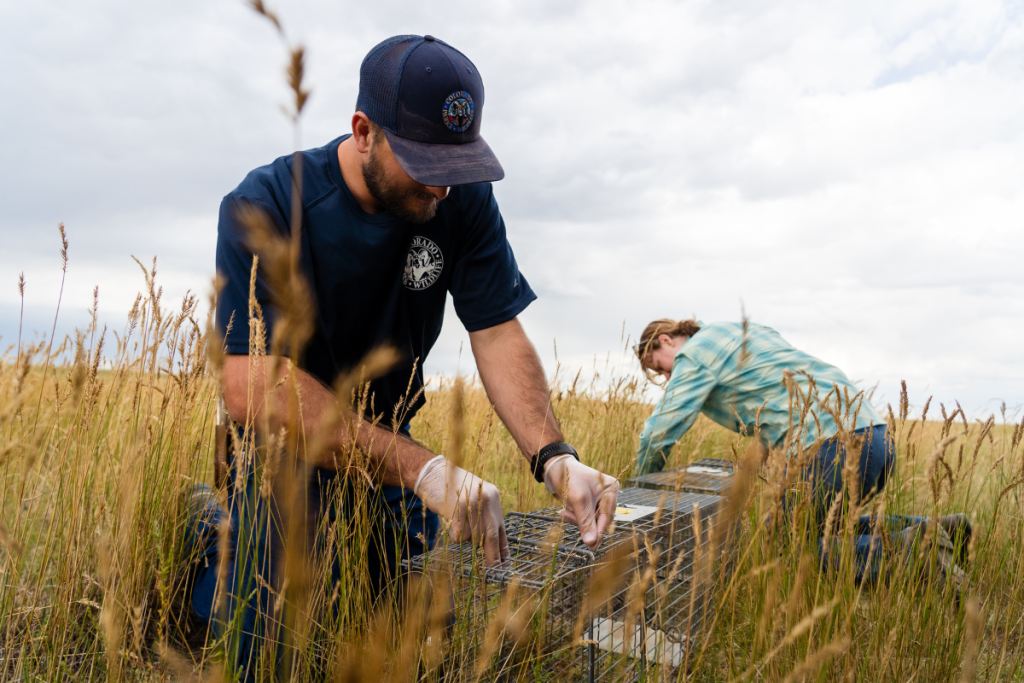CPW, Smithsonian Institute finish successful partnership on swift fox translocation project to Fort Belknap community


Sept 21, 2023
CPW, Smithsonian Institute finish successful partnership on swift fox translocation project to Fort Belknap community
DENVER, Colo. – Colorado Parks and Wildlife and the Smithsonian Conservation Biology Institute have completed the state’s role in a multi-year partnership to restore the swift fox to its native lands on the Fort Belknap Indian Reservation in Montana. The Colorado donation effort ended September 15 with the successful translocation of 18 swift foxes from the Pawnee National Grasslands in northern Colorado. In 2021, CPW and the Smithsonian relocated 30 swift foxes from the Lamar area to Fort Belknap.
CPW biologists, volunteers and Smithsonian scientists set and retrieved dozens of traps over a two-week period. The traps are wire structures using hot dogs or bacon as bait to attract foxes to the area. After capture, the foxes were given a health inspection by CPW veterinarians and fitted with GPS collars before transport to Fort Belknap.
Once the swift foxes arrive in Montana, Smithsonian Institute researchers release them into a pen to better acclimate the foxes to the new environment. After a period of five days, the pen is removed and they can freely roam around their new home. This is known as a “soft release”.
“Colorado has a thriving shortgrass prairie environment to support a healthy swift fox population due to decades of habitat conservation work,” said Wendy Figueroa, CPW biologist. “We are proud our population numbers are strong enough to help the Fort Belknap community restore the swift fox to their lands.”
Montana’s swift fox population is severed between a northern and southern habitat, and the species had not been present on Fort Belknap for more than 50 years. The Smithsonian project to reintroduce the swift fox began in 2020, with the ultimate goal of putting more than 100 swift foxes from Colorado and Wyoming onto reservation land and restoring the ecological connectivity between the two disjunct populations. The project will continue in 2024 in other states.
“Successful furbearer management programs are built on strong partnerships,” said CPW Carnivore and Furbearer Manager Mark Vieira. “CPW invests monumental resources into monitoring swift fox population occupancy and supporting stewardship of shortgrass lands for conservation of all prairie species. It’s the foundational bond between public and private landowners which allows our state’s prairies to support this important species population.”
The swift fox, a nocturnal canid which lives in shortgrass habitat, is a priority conservation species. Between 80-85% of surveyed prairies in Colorado are considered to be occupied by swift foxes and in good condition to support more. The small mammal weighs between three and seven pounds and can reach incredible speeds up to 31 miles per hour.
###
PHOTO CUTLINES:
Top left: A swift fox captured in a live trap set with baits using hot dogs and bacon.
Top right: CPW veterinarians administer vaccines and conduct tests to ensure the foxes are in good health before translocation.
Bottom left: A biologist uses techniques like covering a fox's eyes to calm them during vet exams.
Bottom right: Colorado's shortgrass prairie habitats are ideal for a robust swift fox population.




Colorado Parks and Wildlife (CPW) is an enterprise agency, relying primarily on license sales, state parks fees and registration fees to support its operations, including: 43 state parks and more than 350 wildlife areas covering approximately 900,000 acres, management of fishing and hunting, wildlife watching, camping, motorized and non-motorized trails, boating and outdoor education. CPW's work contributes approximately $6 billion in total economic impact annually throughout Colorado.
DISCLAIMER: The Colorado Parks and Wildlife (CPW) website maintains press releases containing historical information that may no longer be accurate. Press releases are dated, which should be noted to determine whether the information provided is current. Please review our current regulations and brochures for up-to-date information.
 Kara Van Hoose
Kara Van Hoose